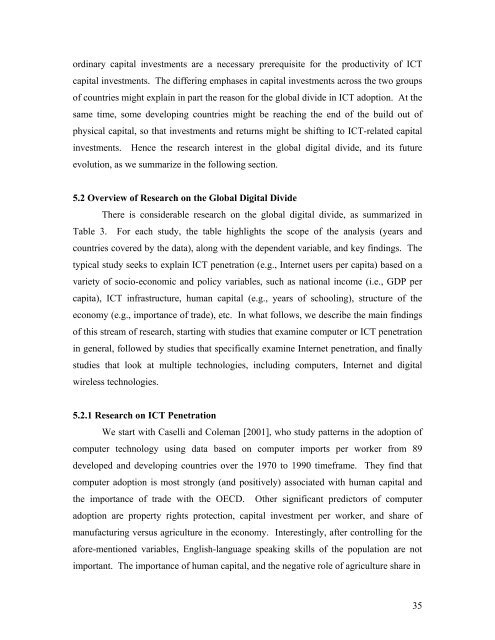The Digital Divide: Current and Future Research Directions - MISRC ...
The Digital Divide: Current and Future Research Directions - MISRC ...
The Digital Divide: Current and Future Research Directions - MISRC ...
Create successful ePaper yourself
Turn your PDF publications into a flip-book with our unique Google optimized e-Paper software.
ordinary capital investments are a necessary prerequisite for the productivity of ICT<br />
capital investments. <strong>The</strong> differing emphases in capital investments across the two groups<br />
of countries might explain in part the reason for the global divide in ICT adoption. At the<br />
same time, some developing countries might be reaching the end of the build out of<br />
physical capital, so that investments <strong>and</strong> returns might be shifting to ICT-related capital<br />
investments. Hence the research interest in the global digital divide, <strong>and</strong> its future<br />
evolution, as we summarize in the following section.<br />
5.2 Overview of <strong>Research</strong> on the Global <strong>Digital</strong> <strong>Divide</strong><br />
<strong>The</strong>re is considerable research on the global digital divide, as summarized in<br />
Table 3. For each study, the table highlights the scope of the analysis (years <strong>and</strong><br />
countries covered by the data), along with the dependent variable, <strong>and</strong> key findings. <strong>The</strong><br />
typical study seeks to explain ICT penetration (e.g., Internet users per capita) based on a<br />
variety of socio-economic <strong>and</strong> policy variables, such as national income (i.e., GDP per<br />
capita), ICT infrastructure, human capital (e.g., years of schooling), structure of the<br />
economy (e.g., importance of trade), etc. In what follows, we describe the main findings<br />
of this stream of research, starting with studies that examine computer or ICT penetration<br />
in general, followed by studies that specifically examine Internet penetration, <strong>and</strong> finally<br />
studies that look at multiple technologies, including computers, Internet <strong>and</strong> digital<br />
wireless technologies.<br />
5.2.1 <strong>Research</strong> on ICT Penetration<br />
We start with Caselli <strong>and</strong> Coleman [2001], who study patterns in the adoption of<br />
computer technology using data based on computer imports per worker from 89<br />
developed <strong>and</strong> developing countries over the 1970 to 1990 timeframe. <strong>The</strong>y find that<br />
computer adoption is most strongly (<strong>and</strong> positively) associated with human capital <strong>and</strong><br />
the importance of trade with the OECD. Other significant predictors of computer<br />
adoption are property rights protection, capital investment per worker, <strong>and</strong> share of<br />
manufacturing versus agriculture in the economy. Interestingly, after controlling for the<br />
afore-mentioned variables, English-language speaking skills of the population are not<br />
important. <strong>The</strong> importance of human capital, <strong>and</strong> the negative role of agriculture share in<br />
35
















